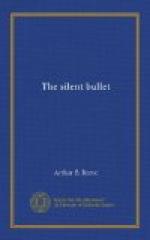It was now Whitney’s chance to air his theory.
“I have always inclined toward the cyanide-of-potassium theory, either that it was administered in a drink or perhaps injected by a needle,” he said. “One of the chemists has reported that there was a possibility of slight traces of cyanide in the mouths.”
“If it had been cyanide,” replied Craig, looking reflectively at the two jars before him on the table, “these blood specimens would be blue in colour and clotted. But they are not. Then, too, there is a substance in the saliva which is used in the process of digestion. It gives a reaction which might very easily be mistaken for a slight trace of cyanide. I think that explains what the chemist discovered; no more, no less. The cyanide theory does not fit.”
“One chemist hinted at nux vomica,” volunteered the coroner. “He said it wasn’t nux vomica, but that the blood test showed something very much like it. Oh, we’ve looked for morphine chloroform, ether, all the ordinary poisons, besides some of the little known alkaloids. Believe me, Professor Kennedy, it was asphyxia.”
I could tell by the look that crossed Kennedy’s face that at last a ray of light had pierced the darkness. “Have you any spirits of turpentine in the office?” he asked.
The coroner shook his head and took a step toward the telephone as if to call the drug-store in town.
“Or ether?” interrupted Craig. “Ether will do.”
“Oh, yes, plenty of ether.”
Craig poured a little of one of the blood samples from the jar into a tube and added a few drops of ether. A cloudy dark precipitate formed. He smiled quietly and said, half to himself, “I thought so.”
“What is it?” asked the coroner eagerly. “Nux vomica?”
Craig shook his head as he stared at the black precipitate. “You were perfectly right about the asphyxiation, Doctor,” he remarked slowly, “but wrong as to the cause. It wasn’t carbon monoxide or illuminating-gas. And you, Mr. Whitney, were right about the poison, too. Only it is a poison neither of you ever heard of.”
“What is it?” we asked simultaneously.
“Let me take these samples and make some further tests. I am sure of it, but it is new to me. Wait till to-morrow night, when my chain of evidence is completed. Then you are all cordially invited to attend at my laboratory at the university. I’ll ask you, Mr. Whitney, to come armed with a warrant for John or Jane Doe. Please see that the Wainwrights, particularly Marian, are present. You can tell Inspector O’Connor that Mr. Vanderdyke and Mrs. Ralston are required as material witnesses—anything so long as you are sure that these five persons are present. Good night, gentlemen.”




